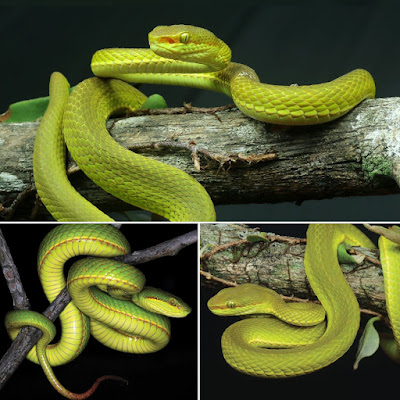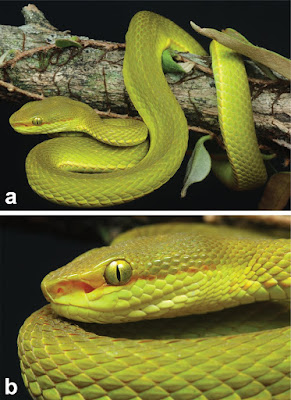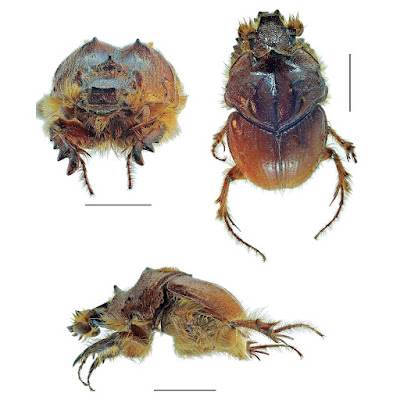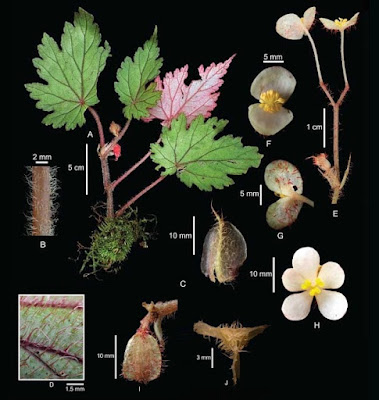[Most Recent Entries] [Calendar View]
Thursday, April 16th, 2020
| Time | Event | ||||||||
| 7:32a | [Herpetology • 2020] Trimeresurus salazar • A New Species of Green Pit Vipers of the Genus Trimeresurus Lacépède, 1804 (Serpentes, Viperidae) from western Arunachal Pradesh, India
Abstract A new species of green pit vipers of the genus Trimeresurus Lacépède, 1804 is described from the lowlands of western Arunachal Pradesh state of India. The new species, Trimeresurus salazar, is a member of the subgenus Trimeresurus, a relationship deduced contingent on two mitochondrial genes, 16S and ND4, and recovered as sister to Trimeresurus septentrionalis Kramer, 1977. The new species differs from the latter in bearing an orange to reddish stripe running from the lower border of the eye to the posterior part of the head in males, higher number of pterygoid and dentary teeth, and a short, bilobed hemipenis. Description of the new species and T. arunachalensis Captain, Deepak, Pandit, Bhatt & Athreya, 2019 from northeastern India in a span of less than one year highlights the need for dedicated surveys to document biodiversity across northeastern India. Key Words: Biodiversity hotspot, Crotalinae, cryptic species, Himalayas, molecular phylogeny, northeastern India, taxonomy
  
Trimeresurus salazar sp. nov. Etymology: The specific epithet is a noun in apposition for J.K. Rowling’s fictional Hogwarts School of Witchcraft and Wizardry’s co-founder, Salazar Slytherin. He was a Parselmouth that links him to serpents. Suggested common name: Salazar’s Pit Viper. Diagnosis: A species of the genus Trimeresurus with (1) 1st supralabial fused with nasal; (2) 19–21 moderately keeled dorsal scale rows at midbody; (3) dorsal colouration greenish yellow in both sexes; (4) an orange to reddish stripe extends from the posterior borders of the preocular, running through the lower margin of the eyes to the lateral side of the nape in males; (5) ventrolateral stripe predominantly yellow with a faint orange at the base in males, yellow in females; (6) tail to total length ratio (TaL/TL) 0.18 in males, 0.14 in females; (7) short, bilobed hemipenis reaching 8th caudal scale; (8) 6 palatine, 15 pterygoid and 19 dentary teeth.
 Natural history notes: the type specimens were found during night search between 1800–2200 hours along a road. Both individuals were found coiled on shrubs along the road. A third individual was seen but escaped in the thick undergrowth. Three individuals were seen during night searches in six nights. Other serpent species observed at the locality include Boiga gokool (Gray, 1834), Boiga cyanea (Duméril, Bibron & Duméril, 1854), and Lycodon jara (Shaw, 1802). For now, the new species is known only from the type locality. The specimens, ZMUC R69255 & ZMUC R69256 were collected from Assam and it is likely that the new species may occur in the adjoining state sharing similar biotope. Zeeshan A. Mirza, Harshal S. Bhosale, Pushkar U. Phansalkar, Mandar Sawant, Gaurang G. Gowande and Harshil Patel. 2020. A New Species of Green Pit Vipers of the Genus Trimeresurus Lacépède, 1804 (Reptilia, Serpentes, Viperidae) from western Arunachal Pradesh, India. Zoosystematics and Evolution. 96(1): 123-138. DOI: 10.3897/zse.96.48431 | ||||||||
| 9:38a | [Entomology • 2020] Pseudoathyreus zianii • Species Delimitation by A Geometric Morphometric Analysis within the Genus Pseudoathyreus (Coleoptera: Scarabaeoidea: Bolboceratidae) and Description of A New Species A geometric morphometric analysis, conducted as part of a taxonomic review of the genus Pseudoathyreus (Coleoptera: Bolboceratidae), allowed us to highlight the differences within a group of closely related species spread from the Sahel region to India, supporting the traditional morphological approach and confirming the presence of a newly discovered species (Pseudoathyreus zianii n. sp.). Keywords: Morphology, biometry, taxonomy, biogeography, arid environments. Pseudoathyreus zianii n. sp. Diagnosis: The new species is easily distinguished from the other two species of the same group by the anterior border of pronotum with a wide-based and a more or less stout conic horn. On the contrary, P. orientalis and P. flavohirtus share a low transverse carina in the middle of APB with the profile of a narrow curly bracket, with either a small and pointed mid-dle horn in the former species or a small and smoothed one in the latter. The central horn of the widespread African species P. porcatus (Laporte de Castelnau, 1840) looks a little like that of P. zianii but is larger, sharkfin-shaped, with a laterally compressed apex. Geographical distribution. Eastern part of the Arabian peninsula (i.e. Kuwait, Saudi Arabian coast on the Persian Gulf, UAE, Oman), southern Iran, southern Pakistan. Name derivation. Named for our colleague and friend Stefano Ziani, renowned specialist of Coleoptera Scarabaeidae, who sent us the material of his collection, including the first specimen that turned out to belong to the new species. Giuseppe Maria Carpaneto and Federico Romiti. 2020. Species Delimitation by A Geometric Morphometric Analysis within the Genus Pseudoathyreus and Description of A New Species (Coleoptera: Scarabaeoidea: Bolboceratidae). Fragmenta entomologica. 52(1); 11–18. DOI: 10.4081/fe.2020.399 | ||||||||
| 11:35p | [Botany • 2019] Begonia medicinalis (Begoniaceae, sect. Platycentrum) • A New Species from Sulawesi, Indonesia
Abstract A new species of Begonia, Begonia medicinalis Ardi & D.C.Thomas, is described from Sulawesi, Indonesia. A photo plate and distribution map are provided. The new species is endemic to Sulawesi and belongs to Begonia section Petermannia. Keywords: Petermannia, Sulawesi Selatan, Sulawesi Tengah, taxonomy, Eudicots Begonia medicinalis Ardi & D.C.Thomas sp. nov. Sect. Petermannia This species resembles Begonia lasioura D.C.Thomas & Ardi (Thomas et al. 2011: 233) in the erect habit, the dense indumentum of relatively long (to ca. 2 mm) hairs of the stems and leaves, and the short peduncles of the female inflorescences, but differs by its lower growth habit up to 30 cm tall (vs up to 60 cm tall); a biserrate to shallowly lobed leaf margin (vs leaf margin serrate); and obovate female flower tepals (vs tepals ovate to elliptic). Etymology:— The specific epithet ‘medicinalis’ refers to the use of this species in traditional medicine in Central Sulawesi (see Introduction; Anam et al. 2014). Wisnu H. Ardi, Muhammad S. Zubair, Ramadanil and Daniel C. Thomas. 2019. Begonia medicinalis (Begoniaceae), A New Species from Sulawesi, Indonesia. Phytotaxa. 423(1); 41–45. DOI: 10.11646/phytotaxa.423.1.5 |
| << Previous Day |
2020/04/16 [Calendar] |
Next Day >> |
















